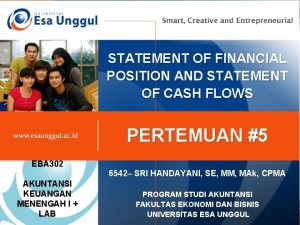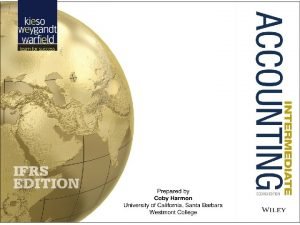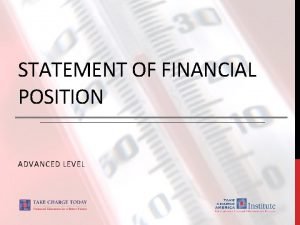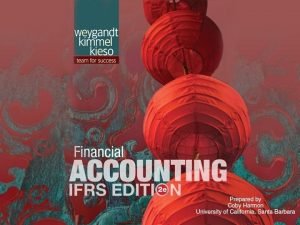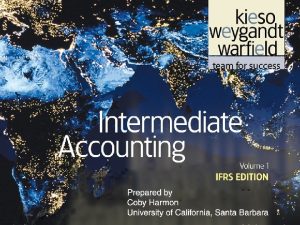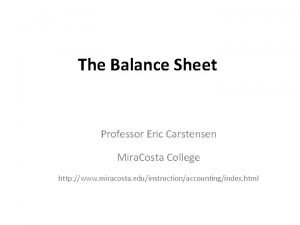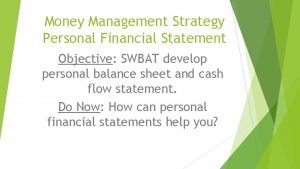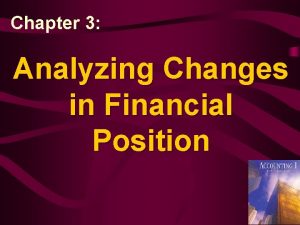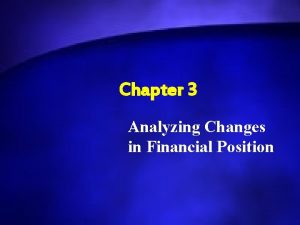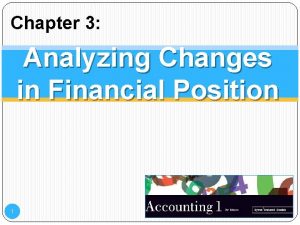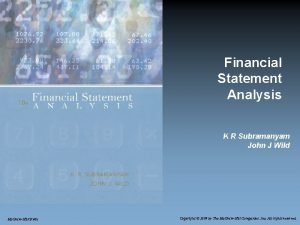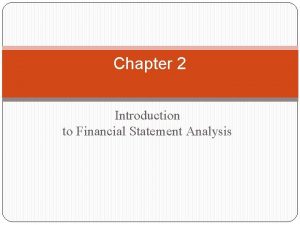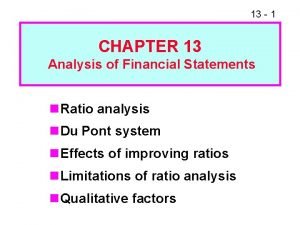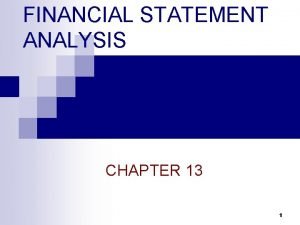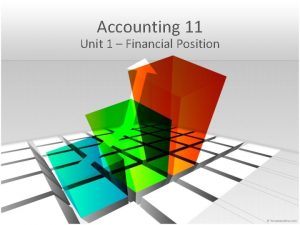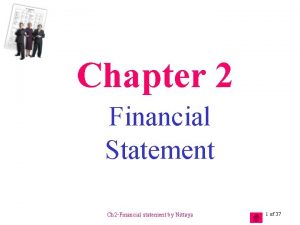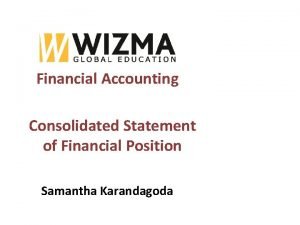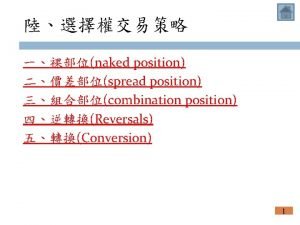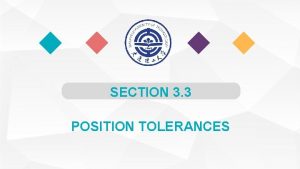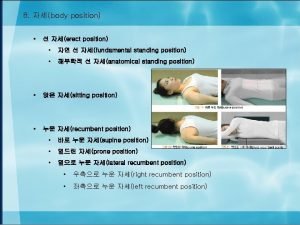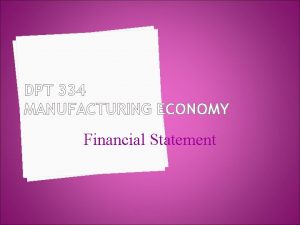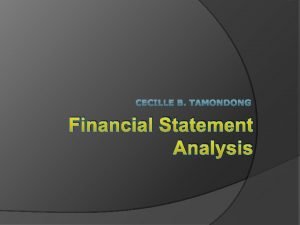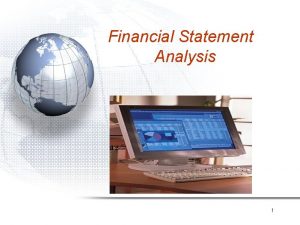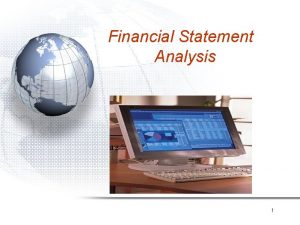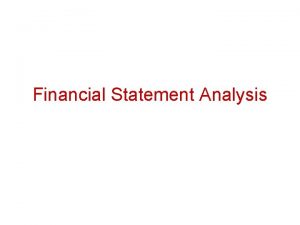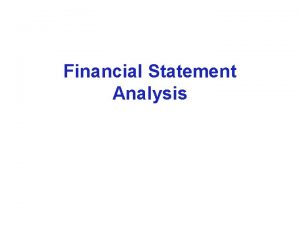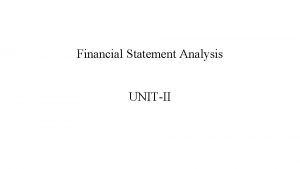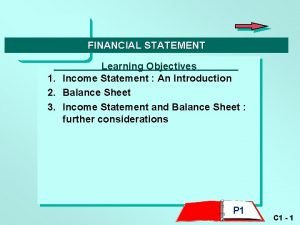Chapter 31 The Statement of Financial Position Learning


















- Slides: 18


Chapter 31

The Statement of Financial Position

Learning Outcomes Upon completion of this chapter you should be able to: • Outline the purpose of a Statement of Financial Position and list its main elements • Distinguish between fixed assets, current assets and creditors falling due within one year • Explain the term ‘working capital’ and understand its significance • Distinguish between authorised and issued share capital • Prepare a Statement of Financial Position • Understand the impact of adjustments to final accounts • Prepare a complete set of final accounts • Prepare a set of final accounts for a not-for-profit organisation.

Statement of Financial Position The Statement of Financial Position illustrates the year end value of a business’s assets and liabilities (creditors) as well as outlining details of its capital structure. The following elements are contained in the Statement of Financial Position: • Fixed Assets • Current Assets • Creditors falling due within one year • Working Capital • Total Net Asset • Capital Employed

Statement of Financial Position Fixed Assets: These are items owned by a business and intended for long term use. Any depreciation in the value of fixed assets must be recorded. Current Assets: Cash, or any asset which can be converted to cash within 1 year. Examples include cash, bank deposits, debtors and closing stock. Creditors falling due within one year: These are short term debts owed by the business. Examples include bank overdraft, unpaid bills and creditors. Working Capital: Current Assets minus Creditors falling due within one year. This provides a good indication of short term liquidity and illustrates whether a business can generate enough short-term income to pay its short term debts.

Statement of Financial Position Total Net Assets: This is also called net worth and shows how much the business would be worth if it were to sell its assets and pay its short term debts. Capital Employed: This is the total of the ‘Financed by’ section of the Statement of Financial position and includes: • Details of the business’s share capital • Details of long term loans taken out by the business • Retained profits or reserves held by the business for future reinvestment.

Share Capital When a company is being set up the owners must set an upper limit for the amount of share capital that can be issued. This maximum limit is called the authorised share capital. The issued share capital of a company indicates the number of shares which the company has actually issued (sold) to date.

Layout of Statement of Financial Position Please turn to page 342 of your Time For Business textbook (Statement of Financial Position of Kahouna Ltd as 31/12/2016) to see an example of a completed income statement.

Adjustments to Final Accounts Sometimes there is additional financial information available which is not contained in the trial balance, but which needs to be included in the final accounts of the business. This extra information is usually listed below the trial balance and will be treated as ‘adjustments’ to final accounts. There are two specific adjustments to final accounts: • Closing Stock • Depreciation

Adjustments to Final Accounts Each of these adjustments need to be entered twice in the final accounts: once in the Income Statement and then again in the Statement of Financial Position. Closing Stock Appears: • In the Income Statement (trading account section) • As a current asset in the Statement of Financial Position Depreciation Appears: • As an expense in the Income Statement • In the fixed assets section of the Statement of Financial Position

Worked Example Please turn to page 346 of your Time For Business textbook (Income Statement of Speed Ltd for year ended 31/12/2016) to see an example of a completed Income Statement.

Worked Example Please turn to page 347 of your Time For Business textbook (Statement of Financial Position for Speed Ltd as at 31/12/2016) to see an example of a completed Statement of Financial Position.

Final Accounts for Not-For-Profit Organisations Not-for-profit organisations such as clubs, charities and community groups also need to prepare final accounts. These accounts are used to support applications for loans and grants and also to show members how money was received and spent during the year. Since these accounts are not required to show profitability they will appear a little different from those prepared by companies and other for-profit organisations. If income is greater than expenditure this will be shown as a surplus rather than a profit.

Final Accounts for Companies and Not-For-Profit Organisations Company Accounts Not-For-Profit Organisations Main goal is to make a profit Profits belong to shareholders, who may receive a dividend Making a profit is not the main goal Surplus income is reinvested to help achieve organisational goals or to benefit members Accounts prepared by accountants and double checked by auditors Accounts prepared by finance officer or treasurer and may be checked by an auditor Income > Expenditure = Profit Expenditure > Income = Loss These are recorded in the income statement Income > Expenditure = Surplus (excess income) Expenditure > Income = Deficit (excess expenditure) These are recorded in the income statement Sales are the main source of income or revenue Subscriptions/donations/grants are major sources of income or revenue Issued share capital is recorded in statement of financial position Accumulated fund is recorded in statement of financial position

Example Income Statement of Barrtown Community Development Association for year ended 31/12/2016 € € Revenue: Donations 18, 000 Grants 27, 000 Fundraising Income 6, 800 51, 800 Less expenditure: Programme expenses 29, 000 Rent 3, 100 Insurance 4, 300 Light and heat 8, 400 General expenses 2, 700 Depreciation on equipment 2, 000 Surplus income 49, 500 2, 300

Example Please turn to page 351 of your Time For Business textbook to see the Statement of Financial Position of Barrtown Community Development Association.

Review and Recap Can you do the following? • Outline the purpose of a Statement of Financial Position and list its main elements • Distinguish between fixed assets, current assets and creditors falling due within one year • Explain the term ‘working capital’ and understand its significance • Distinguish between authorised and issued share capital • Prepare a Statement of Financial Position • Understand the impact of adjustments to final accounts • Prepare a complete set of final accounts • Prepare a set of final accounts for a not-for-profit organisation
 Russian ballet terms
Russian ballet terms Tori's statement of financial position
Tori's statement of financial position Statement of financial position account form
Statement of financial position account form Report form statement of financial position
Report form statement of financial position Statement of financial position assets
Statement of financial position assets Chapter 5 merchandising operations
Chapter 5 merchandising operations Classified statement of financial position
Classified statement of financial position Eric carstensen
Eric carstensen Personal statement of financial position
Personal statement of financial position Equation analysis sheet
Equation analysis sheet Chapter 3 analyzing changes in financial position answers
Chapter 3 analyzing changes in financial position answers Chapter 3 analyzing changes in financial position answers
Chapter 3 analyzing changes in financial position answers Cuadro comparativo e-learning y b-learning
Cuadro comparativo e-learning y b-learning Summary of ratio analysis
Summary of ratio analysis Financial statement analysis subramanyam
Financial statement analysis subramanyam Chapter 14 financial statement analysis solutions
Chapter 14 financial statement analysis solutions Financial statement analysis chapter 2 solutions
Financial statement analysis chapter 2 solutions Chapter 13 financial statement analysis
Chapter 13 financial statement analysis Chapter 13 financial statement analysis
Chapter 13 financial statement analysis


